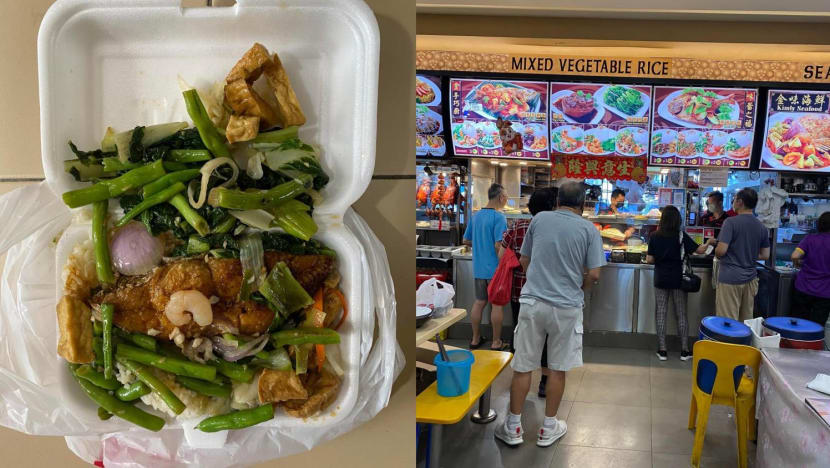S$5 one day, S$9 the next: A look at 'inconsistent' economy rice pricing amid rising cost of living
Economy rice – also called cai fan or mixed vegetable rice – is known as one of the most affordable meals in Singapore. And while gripes about its inconsistent pricing are not new, the issue has resurfaced in line with inflation's rising prices.

Facebook user Gary Huang said he had been charged S$10.20 for the above meal. He also noted the inconsistent pricing from the economy rice stall in Pasir Ris having patronised it regularly. (Photo: Gary Huang)
SINGAPORE: When Mr Gary Huang was charged S$10.20 (US$7.60) for a pack of economy rice with dishes – a slice of fish, bok choy, long beans and tofu strips – in February, he took to Facebook group Complaint Singapore to express his frustration.
In his public post about the economy rice stall at a coffee shop in Pasir Ris, he also noted that he had patronised the stall “for a while now” and could be charged “S$5 on Day 1 and S$9 the next day for ordering the same food”.
“It all depends on which guy is taking my order,” he wrote.
Mr Huang’s post received more than 150 comments, with a few netizens echoing his observation about the “dynamic pricing” of economy rice.
“I never eat cai png (economy rice), cos tend to have dynamic pricing. If demand too high, dish supply less, so charge you $10.20. Demand low and supply high may charge you $7.20,” wrote one.
Another suggested, to tackle the issue, that “all stalls should be required to display their prices of each individual food item prominently”.
However, there were more who pointed out that his meal was priced accordingly due to the slice of fish. It cost S$6, according to the receipt he attached in his post.
INCONSISTENT PRICING
Speaking to CNA, Mr Huang, who declined to reveal any other personal details, said he felt many were “missing some important points” in his post.
“It is about the inconsistencies I’d put up with for an extended period and that the cost of my orders depended on which assistant was serving me. It was not about including a fish in my cai fan,” he said.
He added that there are four hawker assistants at that stall, two who “charge exorbitantly” and two who charge “more reasonably”.
He used to visit this stall in Pasir Ris at least twice a week, but said he hasn’t returned since the incident. He found it “too ludicrous”, even though he is “usually nonchalant” about inconsistent pricing.
“It was only a few days prior when I’d ordered a similar packet of cai fan plus a second one with three dishes, and the total came up to (about) S$11. I couldn’t fathom how just days later that that lone packet of food would have cost me more than S$10,” he explained.
While the cost of his meal was high, “it was more a case of being jaded by their wildly inconsistent pricing”, he added.
Others who spoke to CNA, however, were more accepting of fluctuating prices.
Founder of the Makansutra food guide, KF Seetoh, said inconsistent prices could be due to supply cost for the day, and that “nothing stays the same price”.
“Sometimes, you dole out a bigger portion, you charge a bit more. Inconsistency lies in portioning, not pricing,” he added, suggesting that “actual proof” is needed before accepting the legitimacy of complaints.
A regular customer of her neighbourhood’s economy rice stall, who only wanted to be known as Mdm Jan, noted that the amount charged at such stalls is “based on trust”.
“If it’s late at night, they might want to clear the dishes. So the same dish could be cheaper at night,” the 64-year-old added.
“And you also don’t know how the hawker calculates. Tofu with a few minced meat pieces could be calculated as a meat dish, and would be priced as more expensive (than if it was considered a vegetable dish). If it’s a more expensive fish, you expect it to be pricier.”
LACK OF TRANSPARENCY
While Mr Huang did not intend to draw attention to the fish in his dish with his post, a common response to those who complain about economy rice pricing is to avoid ordering fish.
Fish prices are generally higher and have drastically outpaced the inflation rate. It was reported that prices of various types of fish rose by S$5 to S$10 a kilogram at the beginning of 2023, wrote Associate Professor Lau Kong Cheen from the Singapore University of Social Sciences in a CNA commentary on economy rice pricing.
Nasi padang, which one netizen has described as the “Malay version of cai fan”, has also drawn ire.
In January, a woman told the STOMP website that she was charged S$10.30 for a plate of nasi padang from the ION Orchard food court. Her meal included white rice, black pepper fish fillet, ikan bilis with peanuts and a fried egg.
In February, another contributor to STOMP said he was charged S$10.20 for his nasi padang from VivoCity’s Kopitiam and that the ikan bilis alone was S$4.50.
But underpinning both inconsistent and increased pricing is a lack of transparency, many have suggested.
Some pointed to a hawker “tactic” of charging a vegetable dish as a meat dish if it contains meat, as the latter is typically pricier.
“Clearly, hawkers can put up menu prices to avoid disputes. However, this will incur menu costs for them. Also, I guess, some hawkers aren’t willing to do that, for it takes away their liberty to charge based on their whim and fancy,” said Mr Huang.
“They could, for example in my case, charge a veggie dish as a seafood one by including one tiny prawn. It all boils down to ethics and reasonableness.”
Others acknowledged that different customers could pay different prices for the same dish, depending on the hawker’s rapport with the customer.
“I believe customers may also be judged by servers based on their perception of us," said Mr Huang, but added that his experiences with economy rice and nasi padang stalls have been “largely positive”.
"There could be so many factors: Whether we appear likeable to them, our age and gender, whether we’re affluent, whether we’re docile idiots or aggressive."
Yet customers usually accepted such tactics without complaints prior to the current inflation rate, said some netizens.
CLEARER COMMUNICATION, PRICING
Singapore’s core inflation rate rose by 5.5 per cent in January, the fastest pace in more than 14 years. But hawker food prices outpaced the inflation rate, going up by as much as 8.3 per cent.
Inconsistent pricing at economy rice stalls makes it more difficult for consumers to budget their meals, said Mr Huang.
The solution, he added, could be “like what some commenters (on) my post wrote: Purchase meals like chicken rice and minced meat noodles, where prices are less arbitrary”.
“Singaporeans are known to put up with bad attitudes and service standards, just to satisfy their craving for ‘good’ food. I guess this emboldens errant hawkers. Personally, I don’t believe in supporting bad behaviour.”
Nonetheless, short of entirely avoiding economy rice, nasi padang or similar types of food that require customers to select their dishes, there is a need to display clearer pricing through various means, highlighted Assoc Prof Lau in his commentary.
“Most of these stalls currently do not display the prices of the variety of dishes, or worse, show outdated pricing on their signage,” he wrote.
“Economy rice stallholders can address with some basic colour coding, such as using pegs of different colours on each tray on display, just like what is already practised in conveyor belt sushi restaurants with colour-coded plates or salad bars with some spectrum from basic to premium toppings.”
Food Republic general manager Andy Kiu said that pricing at its chain of food courts is “usually made transparent to the public on the menu board and the portions are generally standardised”.
“But to ensure (the exact) portion is served every single time can be a challenge, since the perceived value or portion is often subjective,” he told CNA.
“At times, you might even get an upsize portion on a goodwill basis from the stalls when they are about to close for the day, as part of their measures to reduce wastage.”
Mr Kiu acknowledged that the rising inflation is a “real challenge” faced by most tenants and business owners, and that “it will definitely take us some time to devise a math that works for everyone".
But Food Republic constantly aims to provide “valuable portions and quality food” at “reasonable pricing”, he said.
Similarly, Kopitiam said its priority is to “ensure that affordable and accessible meal options remain available for the community in spite of rising costs of living”, said general manager Hoo Hoe Keat.
The Rice Garden initiative, launched in 2015, has economy rice stalls that offer a “subsidised meal option” comprising one meat and two vegetable dishes for as low as S$1.50 to ComCare card holders, Mr Hoo said.
The same meal is priced from S$2.50 for Pioneer Generation, Merdeka Generation, senior citizens, CHAS Blue and NTUC union members.
"With 40 Rice Garden stalls located across the island, this initiative provides a balanced meal at a very affordable price for the community," he added.
Makansutra's Mr Seetoh believes that unless one is underprivileged, “everyone else should pay full market price”. People should “accept the fact that food prices are going to rise”, and that hawkers “don’t owe (anyone) a living”.
Even as some stalls put up signboards to be transparent about their pricing, he pointed out that “portions might go down even if prices go up”.
“One less piece of pork, fewer leaves of vegetables. Don’t expect things to remain cheap and full-plated,” he said.
Economy rice customer Mdm Jan said she "doesn't bother calculating" the final cost of her meal even with prices displayed on signboards, aside from an incident when she realised she had been charged S$7.50 for a meal that would usually cost S$5.50.
The hawker, she said, had made a mistake and immediately corrected it.
“Life is already so complicated. Sometimes I don’t even remember the usual price (of the meal). Why bother remembering this sort of thing? If it’s not an extreme difference in pricing, I don’t ask,” she said.
“You also don’t want to spoil that relationship, especially if you order every day. What if the next time they give you a smaller portion? Just let it be.”























